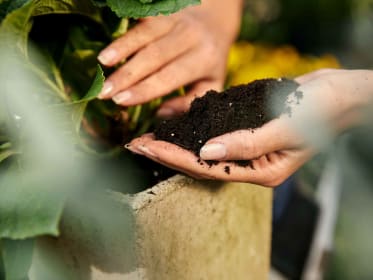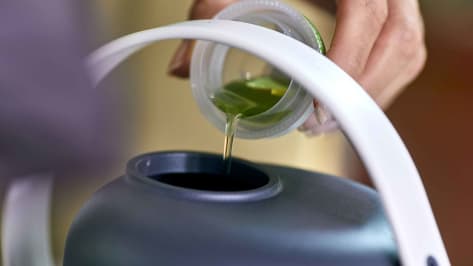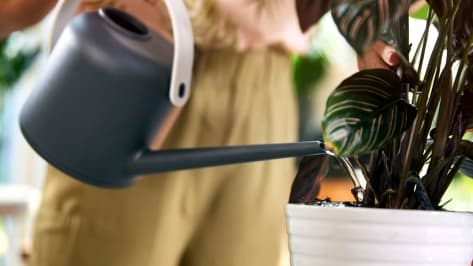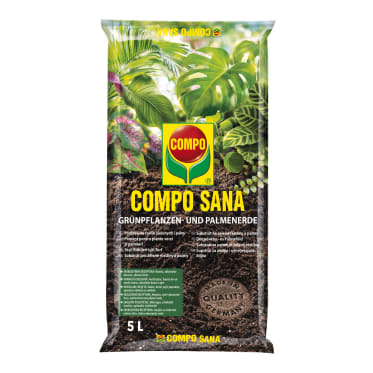Frequent search terms

- COMPO
- Guide
- Plant Care
- Indoor plants
- Houseplants: Repotting and fertilising
Part 2: Basic knowledge
Houseplants: Repotting and fertilising
Basically, they all just need light and water, don't they? Houseplants don't always make things easy for us. They come from regions of the world that are all very different and therefore have their own specific preferences when it comes to location, soil and watering. To ensure your green roommates stay healthy and young for a long time, we want to show you the most important basics of houseplant care. Part 2 is all about repotting and fertilising
The right accommodation
Potting and repotting

Regardless of where you buy your plant, a larger pot means less shelf space and higher transport costs for the shopkeeper. This means that your green roommate will usually arrive at your home in rather cramped accommodation. In places completely occupied by roots, there's hardly any room for soil from which the plant must absorb vital nutrients. Accordingly, a sufficiently large pot and airy soil play an essential role in ensuring your houseplant will remain healthy for a long time.
Which is the right pot?
So, into the nearest pot without further ado? Not such a good idea! You can save yourself a lot of work by choosing the right container. To make it worth the effort, the new pot should be at least 20% larger than the old one. Do not make the mistake of putting the plant directly into a decorative planter. Unlike a plastic pot, this doesn't have any holes in the bottom for drainage, which are key to ensuring that excess water can drain off and there's no waterlogging.
When should I repot?
Spring is the best time for repotting most houseplants. As the temperature and light intensity increase, the plant is just beginning to gather strength again, wanting to grow and form flowers. If you give it a new home with fresh soil and enough space, it will thank you with strong development. The right time to repot winter bloomers, such as the cyclamen, is September before they flower.
Has one of your friends given you a decorative pot containing various flowers? If so, you should start repotting as soon as possible because these pots usually have no drainage holes in the bottom and are planted and decorated far too tightly.
Attention!
Always repot flowering plants after they flower, otherwise the fresh buds will often fall off prematurely.
Caring well for houseplants
Soil and fertilisers

Not all soils are equal – and this is especially true for houseplants, as they don't grow in their natural habitat. Unlike their relatives in the garden, houseplants often die because they are watered too often and suffer root rot. That's why a suitable soil for your green roommate should not absorb water like a sponge but rather remain loosely packed and air-permeable even after watering – the inclusion of sand is especially important for cacti and succulents. Since potted plants should have lush green leaves and not form too many roots or grow too quickly, a special nutrient formula in the soil of the houseplant is also important.
Many soils already contain a so-called starter dressing, meaning the plant is supplied with nutrients for several weeks after repotting. But after that things will eventually get tight. The reason for this is that unlike in a garden, where micro-organisms in the soil take care of humification, there is no natural nutrient cycle indoors. Regular fertilisation is necessary so that the plant still gets everything it needs to remain alive. The easiest way to do this is with a liquid fertiliser that can be poured directly into the watering can. Fertiliser sticks are also easy to use. They are inserted into the soil and slowly release their nutrients over time. You should not fertilise during the dark winter months because many houseplants are then dormant and cannot absorb the nutrients.
How much fertiliser does my houseplant need?
- Once a week: Monstera, fiddle-leaf fig, elephant ear, Zamioculcas
- Once a fortnight: Dragon tree, spathiphyllum, aloe vera, spiderwort, orchid, cyclamen
- Every three weeks: Clusia, cactus, succulents, calathea, indoor palm, sword fern, sansevieria, friendship tree, common wood sorrel
More on caring for houseplants
Our products for your non-flowering plants













